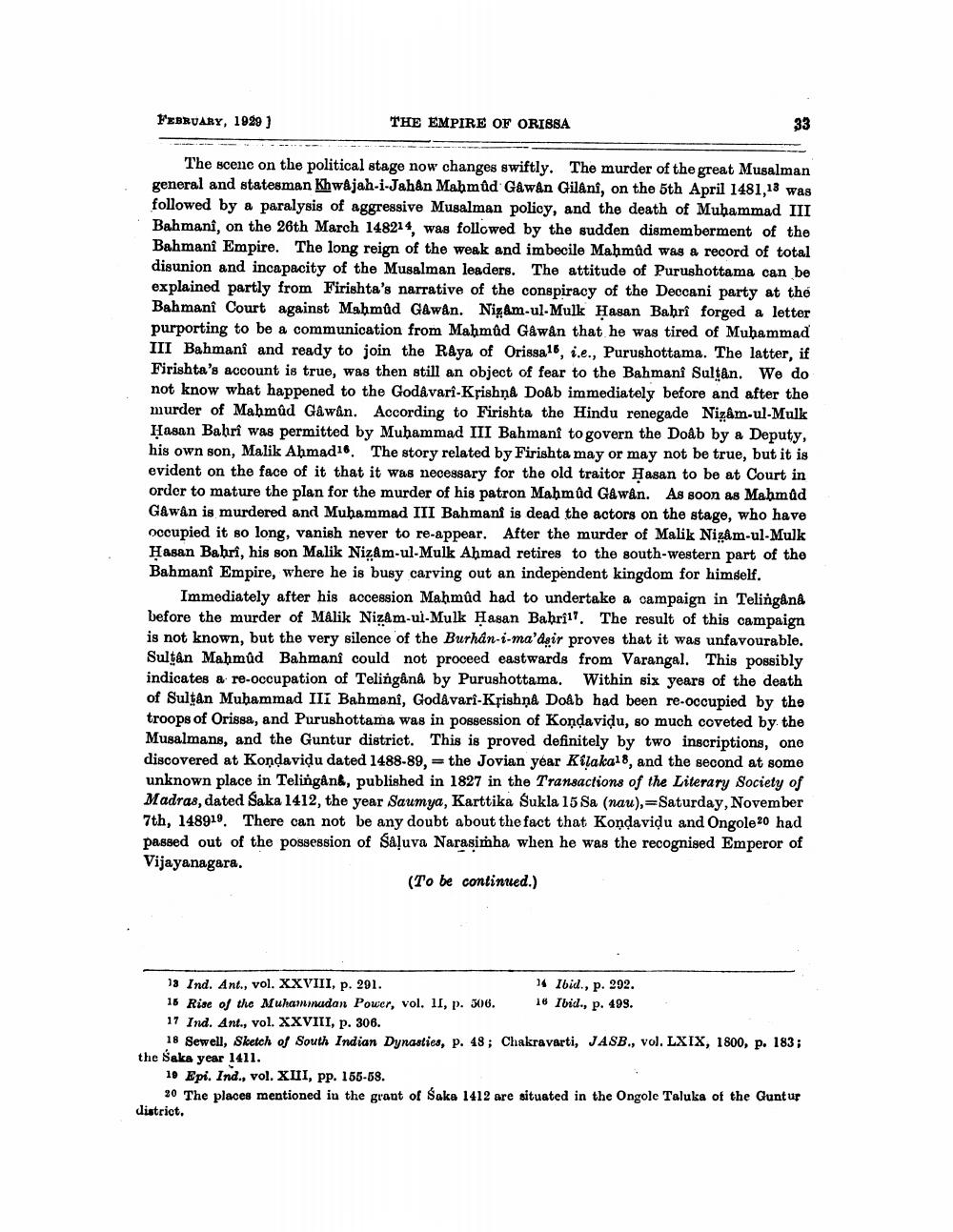________________
FEBRUARY, 1929]
THE EMPIRE OF ORISSA
The scene on the political stage now changes swiftly. The murder of the great Musalman general and statesman Khwajah-i-Jahan Mahmûd Gawan Gilânî, on the 5th April 1481,13 was followed by a paralysis of aggressive Musalman policy, and the death of Muhammad III Bahmanî, on the 26th March 148214, was followed by the sudden dismemberment of the Bahmani Empire. The long reign of the weak and imbecile Mahmûd was a record of total disunion and incapacity of the Musalman leaders. The attitude of Purushottama can be explained partly from Firishta's narrative of the conspiracy of the Deccani party at the Bahmanî Court against Mahmûd Gawân. Nizam-ul-Mulk Hasan Bahri forged a letter purporting to be a communication from Mahmûd Gâwân that he was tired of Muhammad III Bahmanî and ready to join the Raya of Orissa15, i.e., Purushottama. The latter, if Firishta's account is true, was then still an object of fear to the Bahmanî Sultan. We do not know what happened to the Godavarî-Krishna Doâb immediately before and after the murder of Mahmûd Gâwân. According to Firishta the Hindu renegade Nizâm-ul-Mulk Hasan Bahri was permitted by Muhammad III Bahmanî to govern the Doâb by a Deputy, his own son, Malik Ahmad16. The story related by Firishta may or may not be true, but it is evident on the face of it that it was necessary for the old traitor Hasan to be at Court in order to mature the plan for the murder of his patron Mahmûd Gawan. As soon as Mahmûd Gawan is murdered and Muhammad III Bahmani is dead the actors on the stage, who have occupied it so long, vanish never to re-appear. After the murder of Malik Nizam-ul-Mulk Hasan Bahri, his son Malik Nizâm-ul-Mulk Ahmad retires to the south-western part of the Bahmani Empire, where he is busy carving out an independent kingdom for himself.
33
Immediately after his accession Mahmûd had to undertake a campaign in Telingana before the murder of Malik Nizam-ul-Mulk Hasan Bahri1. The result of this campaign is not known, but the very silence of the Burhân-i-ma'dair proves that it was unfavourable. Sultan Mahmûd Bahmanî could not proceed eastwards from Varangal. This possibly indicates a re-occupation of Telingânâ by Purushottama. Within six years of the death of Sultan Muhammad III Bahmanî, Godavarî-Krishna Doâb had been re-occupied by the troops of Orissa, and Purushottama was in possession of Kondavidu, so much coveted by the Musalmans, and the Guntur district. This is proved definitely by two inscriptions, one discovered at Kondavidu dated 1488-89, the Jovian year Kilaka18, and the second at some unknown place in Telingan, published in 1827 in the Transactions of the Literary Society of Madras, dated Saka 1412, the year Saumya, Karttika Sukla 15 Sa (nau), Saturday, November 7th, 148919. There can not be any doubt about the fact that Kondaviḍu and Ongole 20 had passed out of the possession of Saluva Narasimha when he was the recognised Emperor of Vijayanagara.
(To be continued.)
18 Ind. Ant., vol. XXVIII, p. 291.
15 Rise of the Muhammadan Power, vol. 11, p. 506.
17 Ind. Ant., vol. XXVIII, p. 306.
14 Ibid., p. 292.
16 Ibid., p. 499.
18 Sewell, Sketch of South Indian Dynasties, p. 48; Chakravarti, JASB., vol. LXIX, 1800, p. 183; the Saka year 1411.
19 Epi. Ind., vol. XIII, pp. 155-58.
20 The places mentioned in the grant of Saka 1412 are situated in the Ongole Taluka of the Guntur district.




